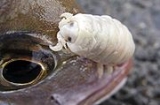
Cymothoa exigua
Encyclopedia
Cymothoa exigua, or the tongue-eating louse, is a parasitic crustacean
of the family Cymothoidae
. It tends to be 3 to 4 cm (1.2 to 1.6 in) long. This parasite enters through the gill
s, and then attaches itself at the base of the spotted rose snapper's (Lutjanus guttatus) tongue. It extracts blood through the claws on its front, causing the tongue to atrophy
from lack of blood. The parasite then replaces the fish's tongue by attaching its own body to the muscles of the tongue stub. The fish is able to use the parasite just like a normal tongue. It appears that the parasite does not cause any other damage to the host fish. Once C. exigua replaces the tongue, some feed on the host's blood and many others feed on fish mucus. This is the only known case of a parasite functionally replacing a host organ. It is currently believed that C. exigua are not harmful to humans unless picked up alive, in which case they can bite. There are many species of Cymothoa, but only C. exigua is known to consume and replace its host's tongue.
In 2005, a fish parasitised by what could be Cymothoa exigua was discovered in the United Kingdom
. As the parasite is normally found off the coast of California
, this led to speculation that the parasite's range may be expanding; however, it is also possible that the isopod traveled from the Gulf of California in the snapper's mouth, and its appearance in the UK is an isolated incident. A tongue louse remains part of the collections of the Horniman Museum
, although it is not currently on display.
Crustacean
Crustaceans form a very large group of arthropods, usually treated as a subphylum, which includes such familiar animals as crabs, lobsters, crayfish, shrimp, krill and barnacles. The 50,000 described species range in size from Stygotantulus stocki at , to the Japanese spider crab with a leg span...
of the family Cymothoidae
Cymothoidae
Cymothoidae is a family of isopods. Several species are parasites, usually of fish. These include the bizarre "tongue-biter", Cymothoa exigua.-Genera:Around forty genera are recognised *Aegathoa Dana, 1853...
. It tends to be 3 to 4 cm (1.2 to 1.6 in) long. This parasite enters through the gill
Gill
A gill is a respiratory organ found in many aquatic organisms that extracts dissolved oxygen from water, afterward excreting carbon dioxide. The gills of some species such as hermit crabs have adapted to allow respiration on land provided they are kept moist...
s, and then attaches itself at the base of the spotted rose snapper's (Lutjanus guttatus) tongue. It extracts blood through the claws on its front, causing the tongue to atrophy
Atrophy
Atrophy is the partial or complete wasting away of a part of the body. Causes of atrophy include mutations , poor nourishment, poor circulation, loss of hormonal support, loss of nerve supply to the target organ, disuse or lack of exercise or disease intrinsic to the tissue itself...
from lack of blood. The parasite then replaces the fish's tongue by attaching its own body to the muscles of the tongue stub. The fish is able to use the parasite just like a normal tongue. It appears that the parasite does not cause any other damage to the host fish. Once C. exigua replaces the tongue, some feed on the host's blood and many others feed on fish mucus. This is the only known case of a parasite functionally replacing a host organ. It is currently believed that C. exigua are not harmful to humans unless picked up alive, in which case they can bite. There are many species of Cymothoa, but only C. exigua is known to consume and replace its host's tongue.
In 2005, a fish parasitised by what could be Cymothoa exigua was discovered in the United Kingdom
United Kingdom
The United Kingdom of Great Britain and Northern IrelandIn the United Kingdom and Dependencies, other languages have been officially recognised as legitimate autochthonous languages under the European Charter for Regional or Minority Languages...
. As the parasite is normally found off the coast of California
California
California is a state located on the West Coast of the United States. It is by far the most populous U.S. state, and the third-largest by land area...
, this led to speculation that the parasite's range may be expanding; however, it is also possible that the isopod traveled from the Gulf of California in the snapper's mouth, and its appearance in the UK is an isolated incident. A tongue louse remains part of the collections of the Horniman Museum
Horniman Museum
The Horniman Museum is a museum in Forest Hill, South London, England. Commissioned in 1898, it opened in 1901 and was designed by Charles Harrison Townsend in the Arts and Crafts style....
, although it is not currently on display.

